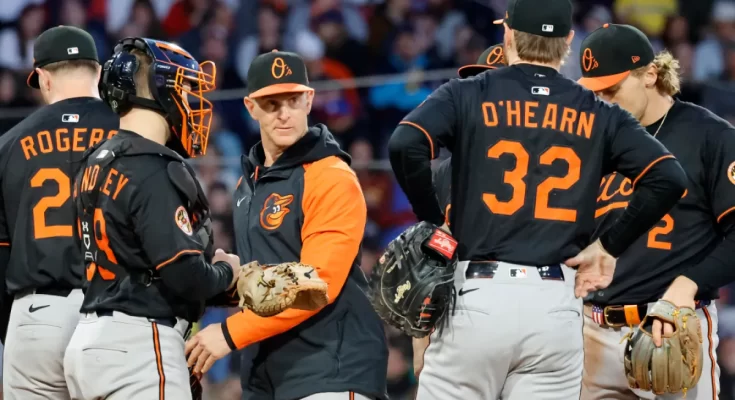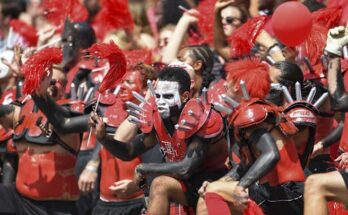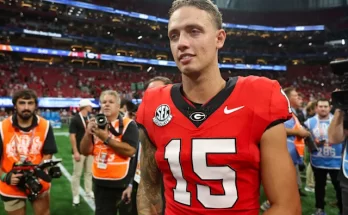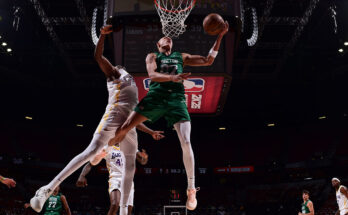Orioles’ Deadline Strategy Revealed: Five Players Likely First to Go as Baltimore Shifts to Buyer Mode
The Baltimore Orioles are preparing to make their most aggressive trade deadline push in decades, but not before clearing some roster space—and according to multiple team sources, five players have emerged as the most likely to be moved first as the club positions itself for a blockbuster summer. MLB Network insider Jon Morosi reported Wednesday that veteran reliever Danny Coulombe, outfielder Austin Hays, and starting pitcher Dean Kremer top Baltimore’s initial trade list, with utility man Jorge Mateo and catcher James McCann also being shopped as the July 30 deadline approaches. This calculated approach allows general manager Mike Elias to address immediate needs—namely frontline starting pitching and left-handed power—while leveraging the organization’s depth to avoid depleting its elite farm system.
Coulombe, the 34-year-old lefty having a career year with a 2.18 ERA and 0.89 WHIP, has drawn interest from at least eight contenders including the Dodgers, Phillies, and Brewers. His affordable $2.3 million salary and postseason experience (3.21 ERA in 14 playoff innings) make him an ideal rental for bullpen-needy teams, and the Orioles believe they can replace his production internally with recent call-up Cade Povich or injured reliever John Means’ impending return. Trading Coulombe now, while his value peaks, follows Baltimore’s pattern of dealing relievers at optimal times—as they did with Jorge López in 2022 and Mychal Givens last summer.
Hays’ situation is more nuanced. The 2023 All-Star has become expendable due to the emergence of Colton Cowser and Heston Kjerstad, but his .287 average against left-handed pitching and reputation as a clubhouse leader could fetch a useful piece from righty-heavy lineups like the Mariners or Twins. Multiple scouts who spoke on condition of anonymity believe Hays could headline a package for a mid-rotation starter, with the Orioles reportedly willing to include cash considerations to facilitate a deal. His $6.3 million salary and extra year of control through 2025 add to his appeal for budget-conscious contenders.
Kremer represents Baltimore’s most intriguing trade chip. The 28-year-old righty is arbitration-eligible through 2026 and has shown flashes of brilliance (3.23 ERA in 12 starts since May), but the Orioles’ logjam of young starters makes him expendable. Rival executives speculate Kremer could command a top-15 organizational prospect alone or be packaged for a bigger acquisition. The Cubs, Cardinals, and Rangers have all inquired about his availability, with Texas particularly motivated after losing Jacob deGrom and Tyler Mahle to season-ending injuries. Kremer’s 4.12 FIP suggests some regression may come, making this an opportune time for Baltimore to sell high.
Mateo and McCann are being marketed as complementary pieces in larger deals. Mateo’s elite speed (20 stolen bases despite limited playing time) and defensive versatility have drawn interest from the Rays and Royals, while McCann’s game-calling expertise and .375 average with runners in scoring position make him an ideal backup catcher upgrade for contenders like Milwaukee or San Diego. Neither would bring significant returns alone, but including them as secondary pieces could help the Orioles land higher-impact talent without sacrificing top prospects like Jackson Holliday or Samuel Basallo.
This phased approach—trading from areas of depth before pursuing bigger fish—shows Baltimore’s maturation as a front office. Last season’s acquisition of Jack Flaherty demonstrated the risks of premature deadline moves, whereas this year’s strategy reflects lessons learned. By first converting expendable veterans into assets, Elias creates roster flexibility and prospect capital that can then be deployed in pursuit of difference-makers like White Sox ace Garrett Crochet or Marlins slugger Jazz Chisholm Jr. Industry sources confirm the Orioles have already discussed Crochet extensively with Chicago, though those talks are on hold until Baltimore clears 40-man roster spots and determines which prospects they’re willing to deal.
The human element of these potential trades shouldn’t be overlooked. Coulombe has become a mentor to Baltimore’s young bullpen arms, Hays is the longest-tenured Oriole, and Kremer was a key piece in the Manny Machado trade that helped launch this rebuild. Moving them signals a cold but necessary shift from development to win-now urgency. “It’s the hardest part of the job,” Elias admitted recently when asked about trading homegrown players. “But our fans deserve a team that does everything possible to win in October.”
Financially, these moves would also serve another purpose: resetting the Orioles’ luxury tax payroll to accommodate potential big-money additions. Baltimore currently sits $12 million below the CBT threshold, and shedding Coulombe, Hays, and McCann’s combined $11.4 million salaries would give them room to absorb a premium arm like Crochet’s $800,000 deal or even take on a larger contract if a surprise star becomes available. This nuanced financial maneuvering—a hallmark of Elias’ tenure—allows the Orioles to maximize their resources without jeopardizing long-term flexibility.
On the field, the immediate impact could be seismic. Imagine a rotation that adds Crochet or Miami’s Jesús Luzardo to front Corbin Burnes, Kyle Bradish, and Grayson Rodriguez. Or a lineup bolstered by Chisholm’s lefty power in left field. These are the types of scenarios Baltimore’s front office is gaming out as they weigh which secondary pieces to move first. The math is simple: every prospect or role player traded from positions of strength (outfield, relief pitching) can be redirected to address weaknesses (rotation depth, bench bats).
For Orioles fans who endured years of meaningless deadline sell-offs, this represents a thrilling reversal. No longer are Baltimore’s best players being shipped out for lottery tickets—now they’re the ones leveraging expendable parts to chase championships. The names may not spark initial excitement (few fans will mourn losing McCann’s .220 average), but the domino effect could reshape the AL East race.
As the deadline clock ticks, Baltimore’s strategy is clear: consolidate first, then attack. By methodically converting depth into trade capital, they position themselves to land impact talent without the desperation that leads to overpays. In a division where the Yankees and Red Sox are also expected to buy aggressively, this disciplined approach might be what separates a good Orioles team from a great one.
The next three weeks will reveal whether these calculated first moves pave the way for the blockbuster Orioles fans crave. But one thing’s certain: after six years of rebuilding, Baltimore is finally playing for October. And that means no player—no matter how beloved—is untouchable if it makes the roster better. The fire sale era is over. The arms race has begun.



